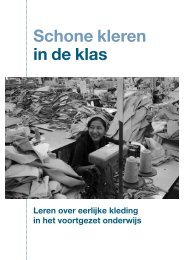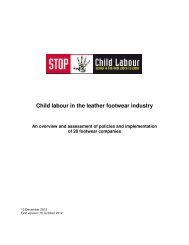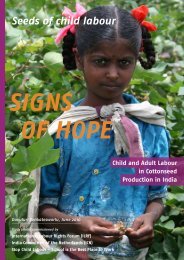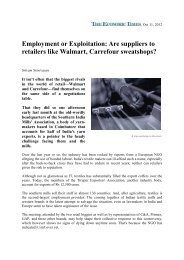Child Bondage Continues in Indian Cotton Supply Chain
Child Bondage Continues in Indian Cotton Supply Chain
Child Bondage Continues in Indian Cotton Supply Chain
You also want an ePaper? Increase the reach of your titles
YUMPU automatically turns print PDFs into web optimized ePapers that Google loves.
Important f<strong>in</strong>d<strong>in</strong>gs<br />
• Table 6 presents the workforce composition <strong>in</strong> 40 sample farms surveyed <strong>in</strong> 2006-07. The<br />
total area covered by 40 sample farms is 45 acres and the average farm size is 1.12 acres.<br />
• A total of 266 children <strong>in</strong> the age group of 7-14 years worked on these farms dur<strong>in</strong>g peak<br />
cross poll<strong>in</strong>ation season. <strong>Child</strong>ren accounted for nearly 55.6% of the total workforce.<br />
Among child labourers 81% were girls. On an average 5.9 children were engaged per one<br />
acre of seed production. Compared to 2003-04, the proportion of children (below 14<br />
years) to the total workforce and per acre employment of number of children has slightly<br />
decl<strong>in</strong>ed. The proportion of child labour to the total workforce decl<strong>in</strong>ed from 67.2% <strong>in</strong><br />
2003-04 to 55.6% <strong>in</strong> 2006-07.<br />
• <strong>Child</strong>ren <strong>in</strong> the age group of 15 to 18 years account for 34% of the total labour force. In<br />
2003-04, this age group of children accounted for only 21% of the total workforce.<br />
• The work <strong>in</strong> cottonseed farms is largely carried out by hired labour. Of the total 478<br />
workers engaged <strong>in</strong> work<strong>in</strong>g on these farms dur<strong>in</strong>g cross poll<strong>in</strong>ation season, 376 of them<br />
(82.8%) were hired labourers and 102 were family labourers. Compared to 2003-04 there<br />
is not much change <strong>in</strong> the proportion of hired labour <strong>in</strong> the total workforce.<br />
• The proportion of child labour to the total workforce was found higher <strong>in</strong> Gulberga and<br />
some parts of Koppal areas compared to Kolar and Gadag districts.<br />
• Compared to 2003-04, there is a marg<strong>in</strong>al <strong>in</strong>crease of 10% to 14% <strong>in</strong> the wage rates paid<br />
to both children and adult labour <strong>in</strong> 2006-07.<br />
Table 6: Trends <strong>in</strong> workforce composition <strong>in</strong> cottonseed farms <strong>in</strong> Karnataka<br />
2003-04 2006-07<br />
Total number of farms surveyed (area <strong>in</strong> acres) 20<br />
(30 acres)<br />
Total number of workers engaged dur<strong>in</strong>g cross<br />
poll<strong>in</strong>ation activity<br />
Type of labour (family vs hired)<br />
% of family labour to total labour 17.2%<br />
(52)<br />
% of hired labour to total labour 82.8%<br />
(250)<br />
Hired labour (local vs migrant)<br />
% migrant labour to total hired labour 8.8%<br />
(22)<br />
% local labour to hired labour 91.2%<br />
(228)<br />
40<br />
(45 acres)<br />
302 478<br />
21.4%<br />
(102)<br />
78.6%<br />
(376)<br />
7.5%<br />
(28)<br />
92.5%<br />
(348)<br />
24







